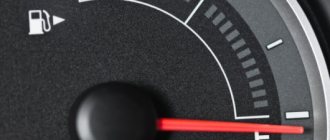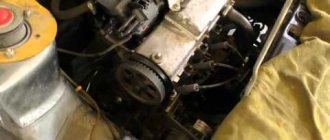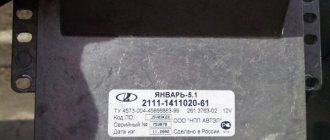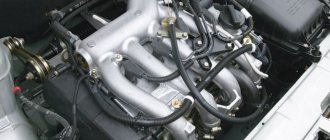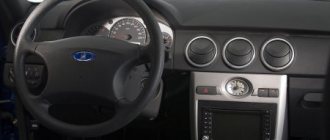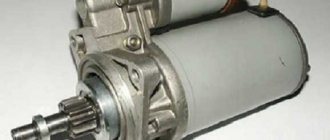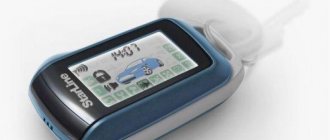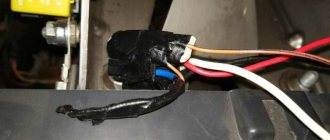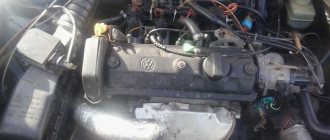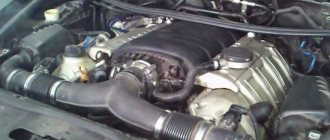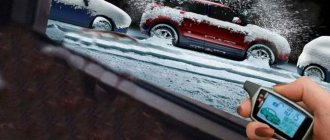Problems after washing the engine are often associated with moisture getting into the electrical wiring connectors and spark plug wells. We will tell you in detail what to do if, after washing under high pressure, the engine stalls, does not start or does not maintain idle speed. Most often, the cause of poor engine performance can be determined and eliminated using available means.
Where to look first?
- Candle wells. Since water is a good conductor of electricity, in the case of flooded wells, the spark begins to flow along the path of least resistance. This means that instead of an electrical discharge occurring between the electrodes of the spark plug, the current begins to flow to ground. This phenomenon is also called breakdown of the spark charge on the engine body. The consequence of the malfunction is a violation of the ignition of the air-fuel mixture in one or several cylinders at once, which is why the engine troits, stalls, and the car jerks when accelerating and driving under load.
- Connector connectors of harnesses in the engine compartment, responsible for the operation of the power supply system and ignition system. First of all, these include the power supply blocks for the ignition coil, fuel injectors, crankshaft position sensor, camshaft position sensor, mass air flow sensor, camshaft position control sensor, etc.
It is worth paying attention not only to the presence of moisture inside the connectors, but also to the quality of contact. High pressure of water from a high-pressure washer can disconnect connectors with damaged clips. Connectors that are not fully latched are poorly visible visually, so if the symptoms described above occur, we recommend that you click through all available power connection blocks.
- Sections of wire harnesses with damaged protective sheathing or damaged insulation. First of all, pay attention to areas that touch the engine, attachments, hoses, pipes, etc. Due to constant vibrations in the engine compartment, harnesses placed in improper places become frayed. If moisture gets into the area of wires with damaged insulation, a short circuit occurs and the readings of the sensor equipment are distorted.
Moisture in the engine - what to do
Since the car is not able to operate correctly due to moisture ingress, all measures must be taken to eliminate it.
Power wiring
To do this, park the car in a dry, warm place, then wipe off any water from the engine compartment with dry rags. The same procedure must be done with the armored wires of the spark plugs. Next, you should check the terminals in the battery - you need to make sure that they are in perfect order. If you notice that they have turned gray, this indicates severe oxidation. Use fine-grained sandpaper and gradually remove the layer of oxidized metal. Naturally, all this must be done in a de-energized car so that you do not get an electric shock.
Check fuses
If moisture gets on the exposed wires of the engine harness, the fuse may blow. Often, one fuse protects the power circuit common to several sensors/actuators. Therefore, a short circuit in one of the sections leads to de-energization of a number of other devices, which is why the engine stalls after washing, does not pick up speed, the automatic transmission goes into emergency mode, etc.
Use a fuse of the same rating for the burnt fuse link. If after installation the insert immediately burns out, there is a short circuit in the circuit. Do not under any circumstances try to install a fuse of a higher rating, as an increase in the current flowing in the circuit can lead to melting of the wires and a fire in the car.
Due to moisture, a gray coating has formed on the battery terminals
When humidity is high, a gray coating appears on the battery terminals, which impairs contact. This usually results in the engine being difficult to start. Therefore, if after finishing the washing you find gray deposits on the battery terminals, disconnect them and clean them.
This can be done using WD 40, a stiff brush or rag. Apply the product to the terminals, wait 10 minutes, then wipe with a rag or use a brush.
Engine won't start after washing
Disruption of current flow due to water getting inside electrical connectors causes a variety of consequences. The starting problem is one of the easiest to solve at home, as it is often caused by either a missing spark or a cut in fuel supply.
To select the direction, unscrew the spark plug, place it on the engine body and have a helper turn the engine with the starter.
During the test, do not hold a candle or high-voltage wire with bare hands. In the case of a cracked ceramic insulator or damaged insulation, there is a risk of severe electric shock.
A spark charge between the electrodes indicates that the ignition system is in good enough condition to start the engine, so it is worth checking the fuel supply. Make sure that the fuse responsible for the constant “+” on the fuel injectors and the fuel pump power circuit is intact. Next, you should check the presence of power and control voltage at the contacts of the fuel pump relay. It is unlikely that the relay itself and the fuel pump could fail after washing the engine, so focus on the condition of the contacts inside the mounting block.
If there is no spark on the spark plug, there is a malfunction in the ignition system, the ECU (Engine Module Control) does not “see” the crankshaft revolutions when the crankshaft is cranked by the starter, or for some other reason it blocks the supply of impulses to the ignition coil.
Where could there be moisture under the hood?
- The first thing you need to do is diagnose the ignition system, since in 80% of cases difficulties appear here more often than usual.
- If the car has distributor, then you should first disassemble it - you can often see a certain amount of liquid under the lid. It is necessary to wipe everything dry with a clean rag, also do not forget about the armored wires and spark plug tunnels. If moisture is difficult to remove from the tunnels, then you can use a compress and blow them out well, so the liquid can be completely eliminated, and it will not interfere with the operation of the internal combustion engine.
Ignition distribution (distributor)
- At blowing spark plugs you should remove the choke, fully depress the gas and only then start the engine. This is the only way to properly blow out the spark plugs and start the car.
- If the ignition system does not have a distributor , then it is necessary to disconnect all the coils, remove them and dry them from moisture. There are both advantages and disadvantages to the distributorless ignition technology. If we compare the distributor ignition system, it is very difficult to remove the cover. Coils are much simpler - you can easily take them out, dry them and install them back. Although on many VAZ cars of the latest version it is much more difficult to get to the ignition coils. Therefore, it is impossible to say unequivocally which ignition system is more efficient in all respects.
- To prevent water from affecting the distributor harmful influence, it is worth treating it and high-voltage wires with WD-40. It is capable of creating a protective film that perfectly repels various liquids.
Distributor in a car
- Also often the cause of moisture ingress is considered to be the formation of crack. It often happens that wires break through, especially often in cold weather, then water can get in there and corrosion of the wiring begins. The best option would be to find the faulty cable and replace it with a new one; the estimated cost can be found in the table below.
High-voltage wires, their voltage, resistance and cost
- Sometimes drivers have this problem - without calculating the damage to the road surface, they fly into a puddle at high speed. This simply causes the liquid to flood the distributor. Thus, the coils and all wiring will become wet , and for this reason it will be impossible to start the car. To eliminate such consequences, you will need to disassemble the distributor and remove all moisture with a dry and clean cloth. After these steps, we also recommend treating these areas with universal WD-40.
The engine is running rough and the Check Engine light is on.
The first step is to blow with compressed air or another available method to remove moisture from the spark plug wells. If there are oxides on the spark plug contact or inside the tip, they should be removed. If there are no positive changes, follow the tips described above - check the connectors and the integrity of the insulation of the areas of the engine harness accessible for inspection.
If the check light comes on after washing the engine, it would be most reasonable to start diagnosing by reading the fault codes. On many cars equipped with the OBD-II protocol, you can read current and stored errors using a pocket scanner like the ELM327 and the right software. Most likely, you will not get full access to the actual engine operating parameters in real time, but you will be able to determine the direction to find the fault that caused the check light to light up and the speed to fluctuate after washing the car.
Troubleshooting
Quite naturally, motorists are interested in what to do if, after washing, the car suddenly does not start. If the problem arose due to the fault of car washers, it is worth filing a claim against them, since in fact they provoked the problems by their actions. But it also happens that the car owner washed the internal combustion engine himself and faced such consequences.
If it turns out that after washing your car your car does not start, the main actions will be aimed at removing the water and moisture that has accumulated there. It may be necessary to replace some components.
Experts recommend performing the work in the following sequence:
- Remove the key from the ignition, remove both terminals from the battery and throw them aside. It is important to turn off the power to the machine.
- Visually inspect the engine compartment and use sponges and rags to remove all visible water.
- Use a dry cloth to wipe the terminals on the battery. If there is any deposit, it can be removed with plain clean water or special cleaners from an auto chemical store.
- Dry all wires that you can reach with rags. This will avoid short circuit.
- Next, the spark plugs are checked. They need to be unscrewed with a special key and dried. If the spark plug is flooded and does not produce a spark, then you will have to install new spark plugs.
- At the same time, make sure that the spark plug wells are empty and there are no signs of water.
- If your car uses a distributor as part of the ignition system, it will need to be removed and disassembled. This will ensure that there is no water under the lid. The device is wiped and dried.
- If there is no distributor, then the ignition coils are removed and dried. It is possible that some coils could burn out. Only replacing them will help.
The issue of hard-to-reach places remains unresolved. Disassembling the entire engine compartment in order to reach there with your hand and rags is not the best solution. While you are dismantling, all the water will evaporate naturally, and some will penetrate even deeper, leading to potentially more serious consequences.
The most correct solution would be to use a compressor or a hair dryer. Air flows are directed under the hood, adjusting the pressure so as not to damage anything. If you use a hair dryer, control the temperature; overheating can cause plastic, rubber elements, wire insulation, etc. to melt.
Jerks during acceleration, blinking check
If the car jerks after washing, this indicates a combustion problem in one or several cylinders at once. The malfunction most often manifests itself during sudden acceleration or driving under load and is often associated with a malfunction in the ignition system. Since misfires lead to the release of unburned fuel into the atmosphere, the OBD2 protocol suggests a characteristic way of signaling misfires - a blinking Check Engine icon. In this case, the self-diagnosis system stores the following fault codes in memory:
- P0300 – multiple misfires detected. The fault code indicates a chaotic combustion disorder in several cylinders at once;
- P0302 – misfire in the second cylinder;
- P0303 – misfire in cylinder #3;
- P0304 – misfire in the fourth cylinder.
All engines have a unified method for displaying combustion problems using diagnostic code P030n, where n is the cylinder serial number.
When reading fault codes, you should understand that errors are recorded by uneven rotation of the crankshaft. The ECU self-diagnosis system is not able to determine whether there is a problem in the ignition system, fuel supply, or whether there is a mechanical defect in the cylinder-piston group. Nevertheless, computer diagnostics greatly simplifies the search for the reason why the engine stalls after washing or the car jerks during acceleration and stalls.
Remove water from mechanisms
In the same way as the water was wiped off before, you need to remove it from the armored wires and candle wells. If the ignition system does not have a distributor, then this will be a little more difficult. You will have to process the coils that are located next to the cylinders. Therefore, armored wires must be checked twice for moisture. You can even wipe the wires under the hood, which already seemed dry, just in case. This can be done with a dry rag. Auto specialists recommend not to rush to start the engine after washing, but first to check, wipe and dry all areas under the hood.
In fact, until the owner encounters such a disaster with his own eyes, he is unlikely to heed such advice. The majority of Russian car owners adhere to precisely this opinion. From all of the above, we can conclude: avoiding problems associated with starting the engine is not so difficult. The main thing is to remember what the consequences of flooding with water may be, especially for such a part of the machine as the engine. With proper understanding of this truth, such a problem as “starting the engine after washing” should not even appear. Flooding with water is a common and unpleasant mistake.
What do motorists think about it?
- It won't start even though everything is dry. “The car does not start after washing, although there is a spark, and the spark plugs are normal. However, it doesn't catch on. I think maybe the fuel isn't reaching the cylinders. The fuel pump is working properly, because the stream is visible. The injectors are still closed. This means EFI is not sending the command."
- Why don't they want to wash the engine?
“If you don’t sell the car, I don’t see the point in flushing the engine compartment. Well, suddenly I wanted it, then I wiped it with a rag and that’s enough! Why fill Karcher? For beauty?! And then suffer! Well, that’s without me!” - Why wash the engine?
“A clean engine is pleasant to maintain; there is no need to scrape off dirt. You can safely change spark plugs and not worry about sand getting into the cylinders. You're about to adjust the valves, and the under hood is clean. If possible, before changing the oil I clean the engine (at work there is a car wash and a foaming agent). It’s clear that this is a little excessive, but everything is normal.”We recommend
“How to change a camshaft oil seal: a detailed step-by-step guide” Read more
- Water is not always to blame.
“The engine of a front-wheel drive car was washed. It started to stall, stalled, and didn’t want to start. I presented it to the washers: it was poorly vented, etc. However, everything turned out to be simple. Before washing, I removed the plastic from the top of the engine, but forgot to put it on. So this piece of plastic closed the hole in the engine with one mounting bolt. As a result, the engine did not want to work due to an air leak on the left, where the bolt should be attached.” - Diagnosis is important.
“Yesterday I was repairing a client’s car... Reason: the car won’t start after washing... In fact, the alarm relay stopped working... Although no water could have gotten on it and this has nothing to do with the wash... Therefore, diagnostics are important, they will indicate the problem!”
Afterword
If the car consistently does not want to work after washing, then the reasons may be small cracks in the distributor cover or in the insulation of armored wires, or insufficient engine tightness. In any case, the fault must be found and eliminated.
On the other hand, such complications are easy to avoid: you should not wash the engine under high pressure; it will be enough to rinse it under a running hose or douse it with a bucket of water. To wash the engine from dirt, you need to purchase high-quality chemicals and begin the procedure or go to a car wash, which can be found on specialized websites, for example, GoBonus.
Should you wash your car engine?
Most car washes offer to wash the engine inside your car. This procedure is carried out using a Karcher high pressure device. We admit that this method is quite dangerous. In this regard, in such places an advertisement is posted warning that they do not guarantee the serviceability of the motor after the end of the wash. During the cleaning process, water pressure can damage engine elements. It is better not to visit these services.
Washing a car engine with chemicals is also quite dangerous. Chemical components can easily ruin rubber and plastic elements. If the integrity of various components is violated, air leaks, oil leakage, etc. are possible. It is not surprising that many car washes that provide this service do not provide any guarantees that the engine will work after the wash is completed.
Washing the power unit with steam is not so dangerous. This process helps get rid of various plaque. At the same time, all the mechanisms that are located under the hood remain in their original form. Oil, resin drips and dust are easily removed using steam pressure. In this case, the spark plugs and air intakes remain dry. This procedure is still little known in our country; therefore, it is used by a small number of motorists.
Finding a service that offers a guarantee is quite problematic. In this regard, in order not to be nervous when the car suddenly does not start after washing, carry out the procedure yourself. The advantage is that for yourself you will perform all actions carefully and the chance of spoiling any element is quite insignificant.
If there is no dirt under the hood, it is not only a pleasing sight to the eye. Most drivers consider this argument quite weighty. However, there are more important reasons for washing the engine:
- Excellent heat transfer is the most obvious advantage of periodically washing the engine in a vehicle, because a layer of dirt disrupts this process. At the same time, overheating of the unit is reduced, ATF retains its performance qualities for a longer period, and engine performance increases.
- Inspection on a clean power unit allows you to identify the slightest leakage of technical equipment. The driver can see problems that have arisen in advance and eliminate them. It is much easier to eliminate malfunctions in the initial stages, when the problems encountered are still minor.
- Minimize electrical problems. In winter, in large cities, roadways are sprinkled with various chemicals. They combine with winter precipitation, resulting in a salt solution. When such drops hit dirt, points appear that conduct current. The result is a loss of energy, which is bad for the battery, which is already subject to heavy loads in the winter. In the worst case, there may be a short circuit. If the engine is free of dirt, then it will not be afraid of such problems. It is not recommended to wash the power unit in cold weather. Even when drops of saline solution and slurry from snow fly under the hood, the washed surface of the unit does not allow them to settle there. Drivers who are very worried about their car can wipe the engine compartment with a rag.
- Maintenance and diagnostics of the engine becomes more convenient, because the place where the power unit is located does not contain dirt. It is pleasant to carry out a routine measurement of the ATF volume in the crankcase, since the engine and all adjacent mechanisms are sparkling clean and you don’t have to worry about getting dirty. All manipulations with the battery are also carried out without problems: charging or replacement.
There is only one problem - the car may not start after washing. However, this is a rather significant and unpleasant drawback.
